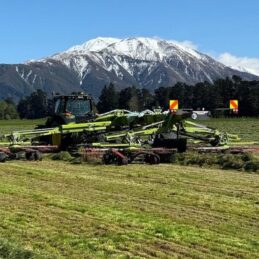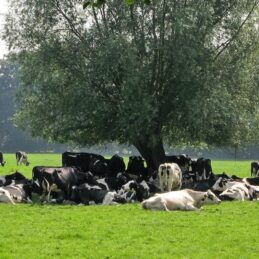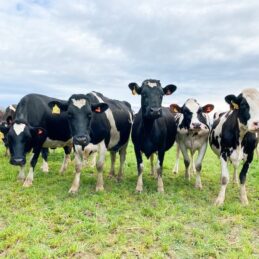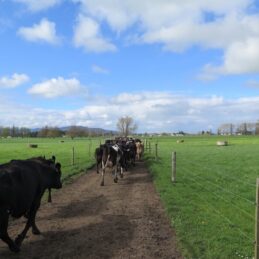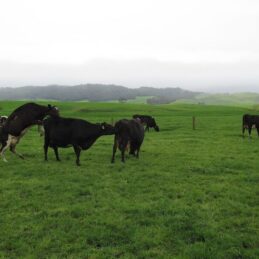Heat stress negatively affects both animal welfare and production. The heat stress an animal experiences is a combination of temperature, humidity, solar radiation and air flow. It is important to provide shade, fresh clean water and optimal nutrition to help support livestock during times of heat stress.
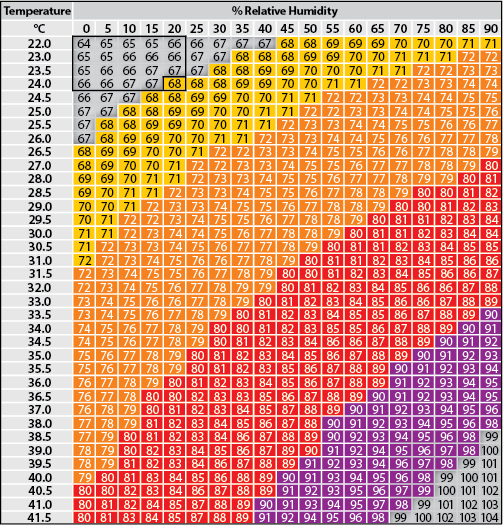
Heat Stress in New Zealand
While New Zealand may not have the extreme temperatures seen in other parts of the world, the high relative humidity means that heat stress occurs at much lower temperatures than other areas.
- Average NZ humidity in February is ~ 80%
- Cows will begin to experience heat stress at 22°C
- Mild-moderate heat stress will occur at 24°C
- Moderate-severe heat stress will occur at 29°C
Yellow = stress threshold
Orange = mild-moderate stress
Red = moderate-severe stress
Purple = severe stress
Heat Stress Impact on Milk Production
| Practical Examples of Heat Stress | NZ 80% Relative Humidity | Lost Milk Production (per hour exposed) | Lost Milk Production (per cow per day) |
|---|---|---|---|
| Stress Threshold (THI 72-79) | 22°C - 23°C | -22.3 cents/cow/hr | -$0.89 (4 hrs) |
| Mild-Moderate Stress (THI 72-79) | 24°C - 28°C | -23.8 cents/cow/hr | -$2.15 (9 hrs) |
| Moderate-Severe Stress (THI 80-89) | 29°C - 35°C | -24.8 cents/cow/hr | -$2.96 (12 hrs) |
| Severe Stress (THI 90-99) | 36°C + | Severe = not measured |
*Assuming $9.30 payout and 8.5% solids
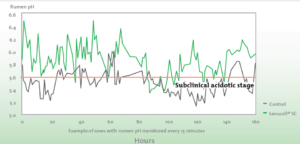
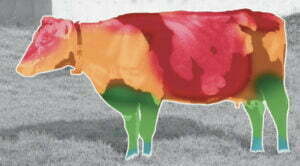
Red areas = show where heat is generated and dissipated.
Heat Stress Increases Risk of Rumen Acidosis
Cows under heat stress will typically avoid fibrous feeds to reduce internal heat generation in the rumen.
This puts them at risk of rumen acidosis under heat stress conditions, even if only a small amount of carbohydrates are fed (e.g. turnips, grain, tapioca, fodder beet, maize silage).
Levucell® SC significantly reduces time with rumen pH <5.6 in both heat stress and non heat stress conditions.
A study conducted at the University of Florida showed a significant reduction in the number of cows at risk of rumen acidosis when feeding Levucell® SC under heat stress conditions. This was published in the Journal of Animal Science (Vol 88) and Journal of Dairy Science (Vol 93).

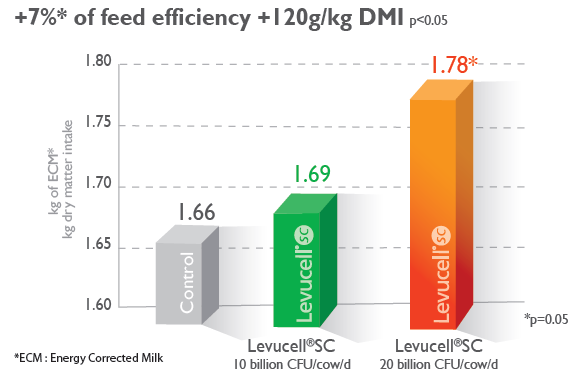
University of Florida, Journal of Animal Science (Vol 88) and Journal of Dairy Science (Vol 93)
Feed Conversion Efficiency
Improved feed conversion efficiency with Levucell® SC also occurs under heat stress conditions
- If Levucell® SC is fed at 2g under heat stress conditions the return on investment (ROI) is 6:1
- Standard Levucell® SC ROI is 6.5:1 under non heat stress conditions
- Responses on grazing trials have been as high as 110g milk/kg DMI 14.4:1
- Moderate-severe heat stress will occur at 29°C
ROI assumptions: 8.5% solids and $9.30/kgMS payout
10 billion CFU in NZ is a standard 1g dose rate
20 billion CFU is a double dose rate in NZ recommended under heat stress conditions.
Summary of Levucell® SC heat stress trials
| Trial Reference | Animals | Environment | Effect of S. c. I-1077 on feed efficiency | Effect of S. c. I-1077 on rumen pH | Other indicator |
|---|---|---|---|---|---|
| University of Florida (Marsala et al., 2010) | 60 dairy cows | Severe heat stress | + 7% | Lower % of cows with rumen pH <5.8 | |
| New York State (2004) | 300 dairy cows | + 9% | |||
| Bologna University (Fustini et al., 2013) | 40 dairy cows | Mild to moderate heat stress | + 6.5% | Improved | Improved fibre degradation and rumination |
| University of Tehran (2013) | 36 dairy cows | Severe heat stress | + 8.5% | Increased | Improved manure consistency |
Summary of University trials with live yeast Saccharomyces cerevisiae CNCM I-1077 under heat stress conditions
Levucell® SC or Sodium Bicarbonate for rumen acidosis?
Both improve rumen pH, however Levucell® SC significantly reduces time below pH 5.8
Use both if required, however Levucell® SC is a more economical and effective long term tool to help prevent SARA
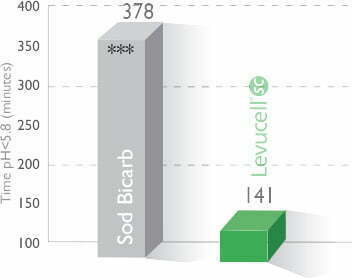
150g sodium bicarbonate = 24 cents per cow per day
1g Levucell® SC = 8 cents per cow per day
Fibre Digestibility – important for summer grazing
Levucell® SC has a positive effect on NDF digestibility in more than 180 different forages.
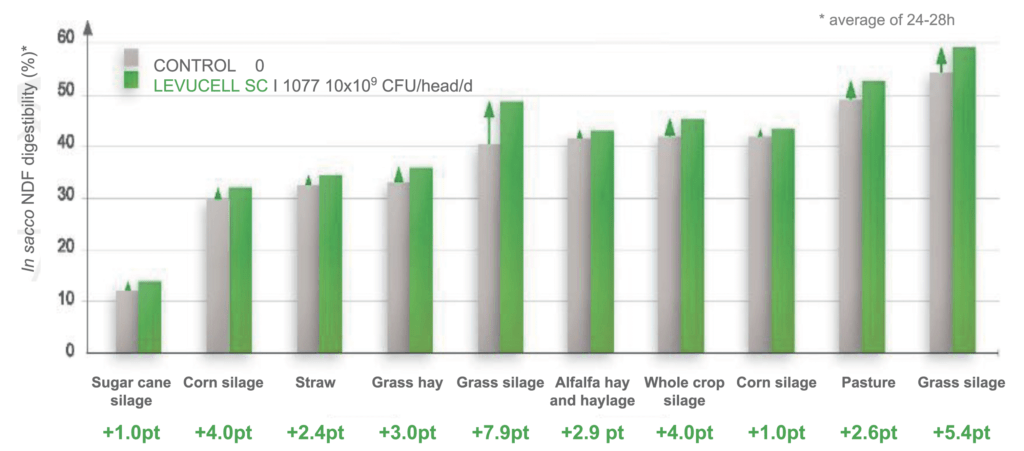
**Oba & Allen 1999, J Dairy Sci 82:589–596. Guedes et al., CECAV Portugal, 2008. Anim Feed Sci Technol 145:27-40, Guedes et al., CECAV Portugal, 2010. Proceeding from Wageningen Symposium, Netherlands pp 25-30, Gomez M.J. et al, CECAV Portugal, Congresso de Zootechnica 2015. Chaucheyras-Durand F. et al., INRA France, 2010, J Dairy ScJ. Anim. Sci. 88 (S2)/J. Dairy Sci. 93 (S1) : 145, Walker and Cintora, BRI, Canada 2010, Ding G. et al, China Agricultural University, China, 2014 J. Anim. Sci. and Biotech. 5 :24, Souza D.O. Lallemand Internal report, University of São Paulo, Brazil, 2015, Souza D.O., University of São Paulo, Brazil, 2018, Anim Feed Sci Technol 236:149-158
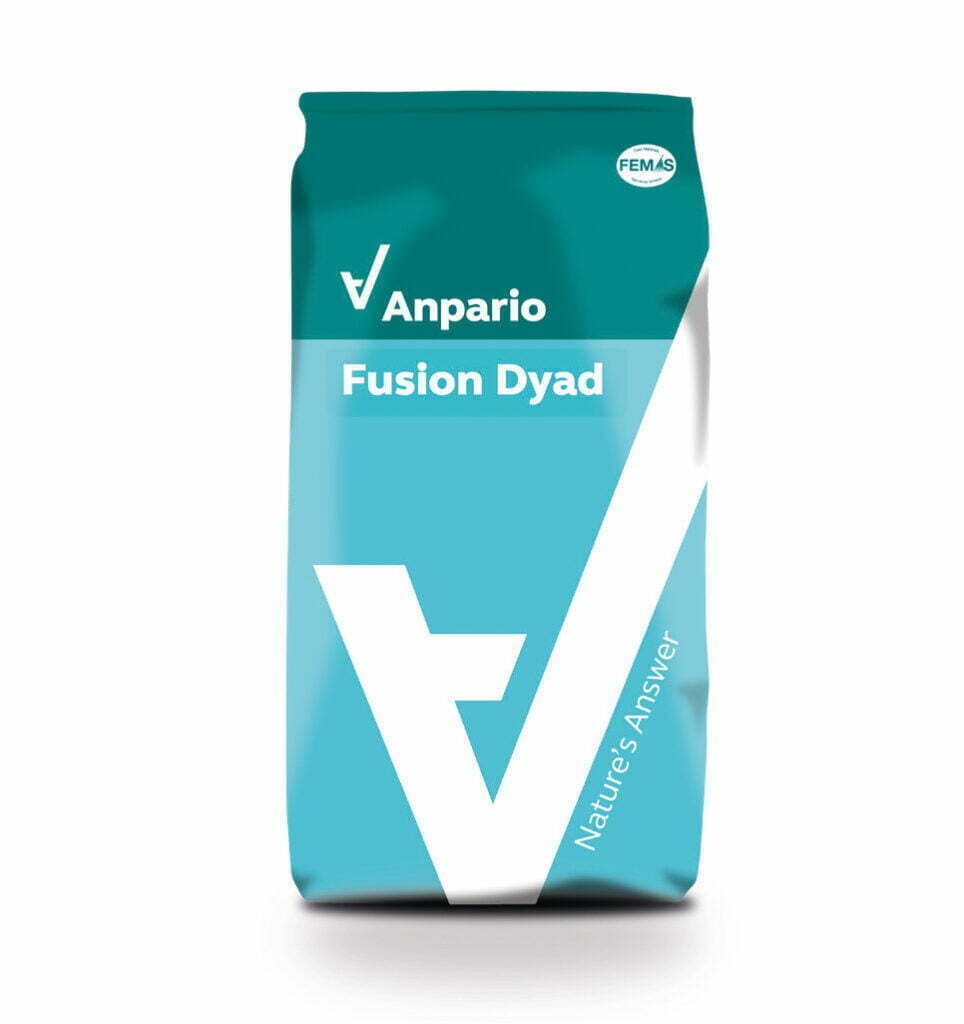
Mycotoxins
Mycotoxins are toxins produced by fungi. There are thousands out there, and they are present all the time, however the risk for cattle, sheep and goats increases when the environment around the feed changes, for example, hot spots and warm, humid weather.
Mycotoxin binders can help reduce the impact of food borne mycotoxins. It is important to look for one that contains both clay and yeast cell wall (e.g. Fusion® DYAD) to give the best possible protection from a range of mycotoxins.
Clay helps reduce the risk of Aflatoxins, Fumonisins, Lolitrem-B & Ergot alkaloid mycotoxins while yeast cell wall components work well on Zearalenone.
Oxidative Stress Under Heat Stress Conditions
- Total antioxidant status is lower in the summer (Turk et al., 2015).
- Summer heat increases reactive oxygen metabolite substances and decreases total carotenes and vitamin E in mid- lactating cows (Calamari et al., 1999).
- In addition, heat stress increases antioxidant enzymes activities (Slimen et al., 2016).
- The Nutritech Heat Stress pack features extra antioxidants to help alleviate the negative effects from heat stress. The additional Vitamin E, organic selenium and primary antioxidant enzyme Melofeed® provides a powerful antioxidant top up to your regular mineral nutrition.
![]()
Nutritech Rumen Health Pack
Use to top up your current mineral/additive programme as an aid in reducing heat stress.
Active ingredients:
Contains per 15g dose:
Fusion™ DYAD *: 10g (to provide 533g/kg bentonite and 133g/kg of inactivated yeast), Levucell® SC 10 ME: 1g (1×1010 CFU), Melofeed®: 50mg, selenium (organic): 1mg, vitamin E (natural): 35mg.
Recommended Dose rate:
Moderate to severe heat stress: per day 12-25kg feed – 30g
Mild-moderate heat stress: per day 12-25kg feed – 15g
Directions for use:
Administer to adult cattle by mixing with supplementary feed (cereal/fibre) at the recommended rates. Mix homogenously with other feed ingredients.
Cautions:
If symptoms persist, veterinary advice should be sought.
By Law, the user must take due care, obtaining expert advice where necessary, to avoid unnecessary pain and distress when using the product other than that as directed on the label. The product is for use in feed that meets industry standards for animal feedstuffs. It is not for use to modify feed that has unacceptably high levels of mycotoxin contaminants. This product may decrease the effectiveness of other oral medicinal products given concurrently with this additive.
Storage:
Reseal packaging after use. Keep in a safe place away from foodstuffs. Store in a cool, dry place out of direct sunlight. Avoid contact with eyes, inhalation and ingestion. Wash hands thoroughly after use. Keep out of reach of children.
* Fusion™ DYAD is a registered pursuant to the ACVM Act 1997, No A011062 contains 800g/kg bentonite and 200g/kg inactivated yeast. See foodsafety.co.nz for registration conditions.

